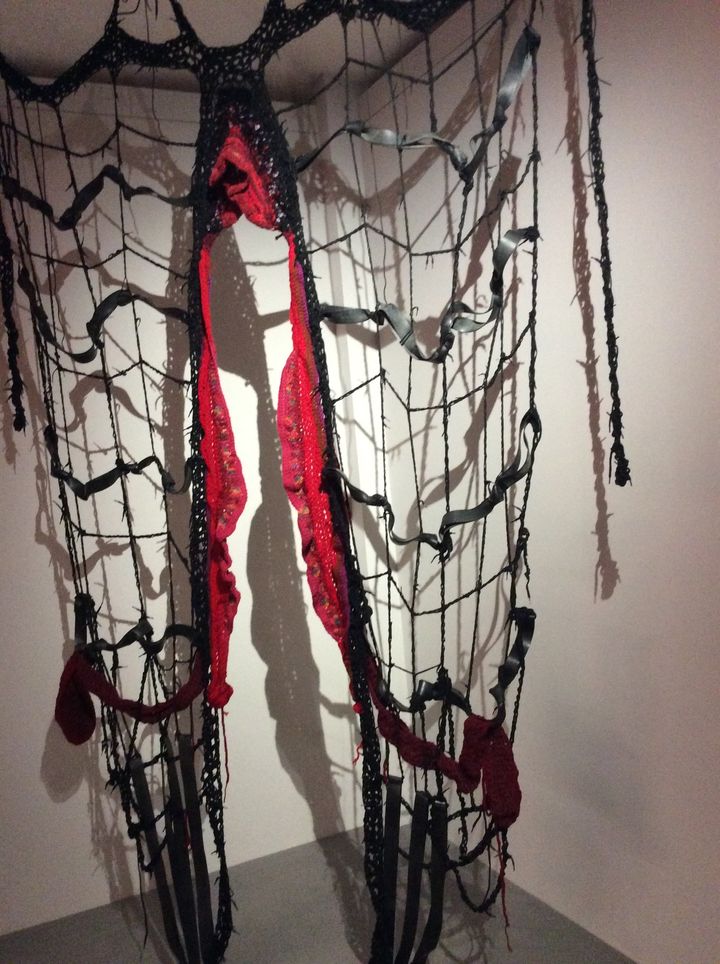
Crocheted Womb by Faith Wilding
Vaginas flutter in the morning breeze. Chromatic breasts dominate the central courtyard. And if you can, if you dare, walk inside a gigantic woven steel tea kettle while weary washer women scrub and scrub and scrub on the second floor of this palace by the Seine, once known as the House of Money. Or La Monnaie, historically the main mint for the long disappeared French Franc, and later for Euro coins.
La Monnaie is the newest of France’s art palaces, six years under restoration and housing both contemporary paintings and sculpture as well as a formal working museum of the history of coinage. What could be a better opening show in this Weinstein moment than Women House—a celebration of women’s historic and penurious struggle for justice and equality in a world dominated by a pussy grabbing president and a rape threatening Hollywood mogul?
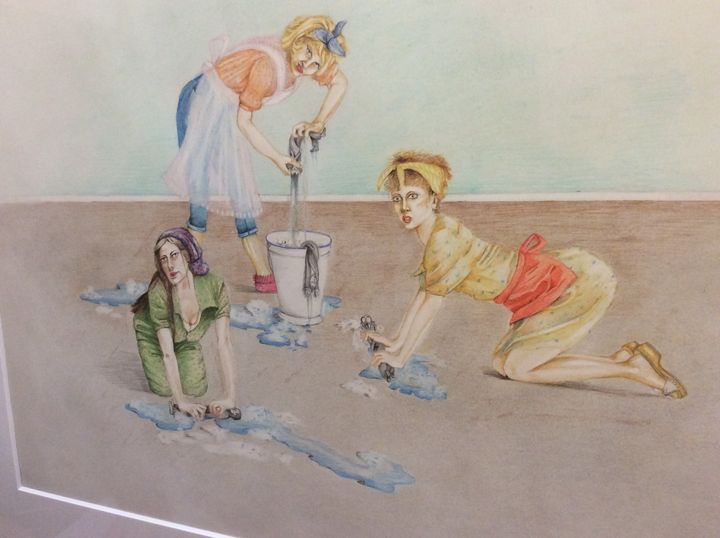
Birgit Jurgenssen, Scrbbing the Floor
Women House houses some of the greatest names in 20th century art: Louise Bourgeois, Nicki de Saint Phalle, Cindy Sherman, Joana Vascancelos, Birgit Jûrgenssen, Claude Cahun and Zanele Muholi—not to forget Judy Chicago.
The show’s title carries multiple meanings, beginning with Virginia Wolf’s plea nearly a century ago for women to have “a place of one’s own” in a male ordered world. The many works of late 20th century feminists aim directly to demystify and de-objectify the anatomy of female primates, humans included. Rich irony is equally present in a score of images that look closely at how the houses that have been historically owned by men were mostly maintained by women—or as a friend’s mother once screamed during a family fight: “I don’t live here; I just work here.”
The exposition requires time and reflection on a number of fronts. We are asked to consider carefully what even the word “house” or the phrase “to house” means and has meant through history—be it a distinctly “feminine” yurt made of fabrics that nomadic women could (and did) construct and carry on their backs, or a zone of comfort where men made business deals while poorer women polished the silver and nannied the children. Not to forget mobile homes and doll houses. To that degree architecture is implicated throughout the “eight chapters” of the exposition, be it the architecture of housing or the human architecture that both idealized and dehumanized female bodies and genitalia.
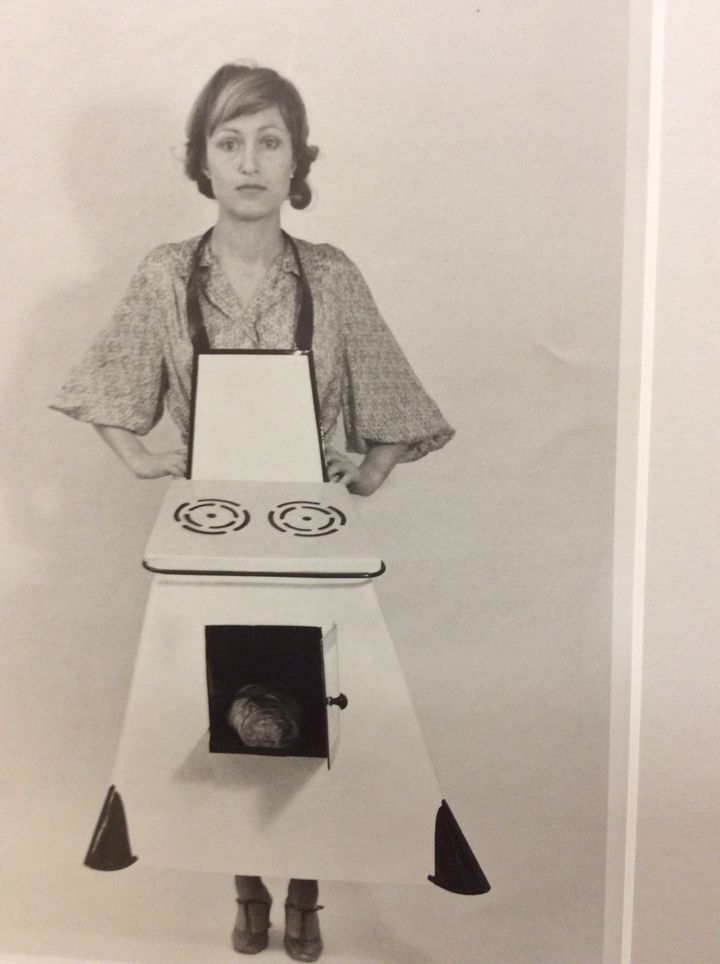
Birgit Jûrgenssen, Housewives
For most of western history the physical reality of women has been effectively airbrushed over, replaced by the fantasy curves admiring men salivate over. Not until Gustave Courbet’s Birth of the World, had any vaguely realistic portrayal of female sex been presented in fine galleries—and even Courbet covered everything in a forest of fur. Not the slightest hint of clitoral, labial or vaginal reality. What makes this show original is the artists (all women) insistence on merging the physical with the social, as in Jürgenssen’s depiction of a woman’s genitive zone as a home oven for preparing family dinner.
A large portion of the works have been lent to La Monnaie by Washington’s National Museum of Women in the Arts, the world’s only major museum devoted to women artists. For the French, as well as for many contemporary American women artists, that label, that identity, poses its own problem. The official French Left has always ridiculed the American propensity for group identity, or identity politics, as juvenile and ahistorical, and it still mostly does. At the same time, the success of the last generation’s militant feminist artists, has clearly opened the door to a younger generation of women who simply want to be recognized for their work, not for their femininity. That silent cleavage is loud and clear in Women’s House: the vast majority of work comes from the height of the feminist movement in the 60s and 70s.
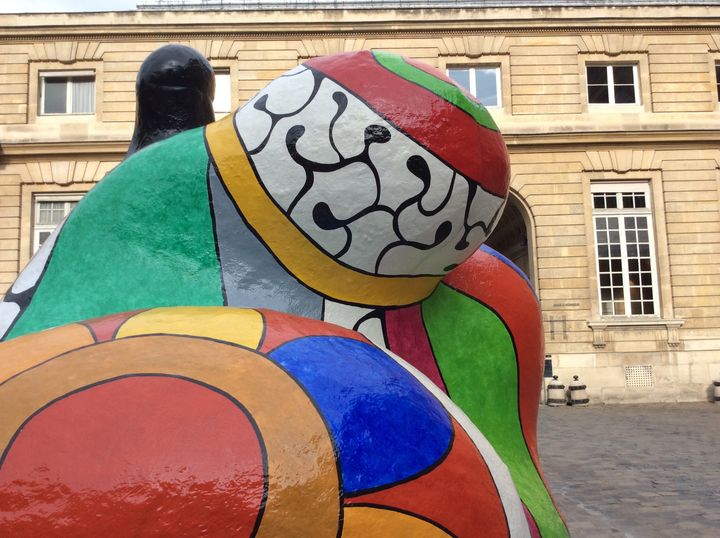
Nikki de Saint Phalle, Nana-Maison
Even being included in a women’s identity master show like this one seems offensive to many of today’s creators. If there is a critique to be made of Women’s House, it is the absence of that artistic dilemma in the show, especially as the Harvey Weinstein/Donald Trump cases have just spawned a worldwide outcry over powerful men’s ongoing abuse of women.
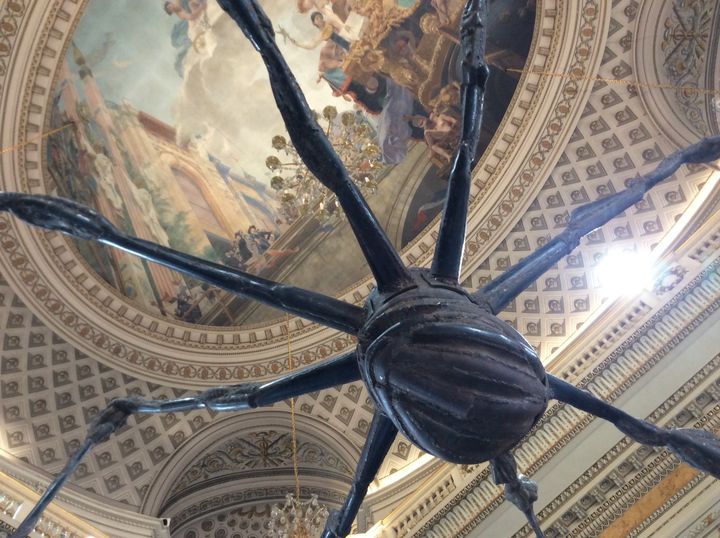
Louise Bourgeois, Steel Spider
* * *
MEANWHILE, across the Seine and up the Champs Elysée, another much smaller exhibit has opened at the Gagosian Gallery. With 16 galleries the Gagosian organization is possibly the richest art marketing combine in the world. Gagosian Paris (which has a considerable stake in the Picasso heritage) is offering a collection of rarely seen works mostly concerned with his daughter Maya. He created them them mostly in his middle age when he was said to be the model doting dad.

Maya with doll and horse, photo Rob McKeever, Courtesy Gagosian.
If Picasso largely defined human abstractionism for the 20th century, especially that filled with blatantly erotic figures and shapes, these portrayals of Maya are gentle, sweet and offer ample testimony to his genius as a conventional draftsman. They are testimonies to the sublime love of a father for his daughter.
And they too are worth millions, perhaps hundreds of millions. Moments after we entered Gagosian Paris a whirlwind of pointedly wealthy young Asians swept into the first floor gallery, giggling and guffawing as the show’s curator, Diana Widnaer-Picasso, one of Picasso’s grandchildren, amused and regaled the potential Asian checkbooks with personal tidbits about her granddad, his work and his role in 20th century art.
Art, after all, is about money as much as it is about transcendent beauty—and the hustle and struggle for growing and parsing out that mega-million dollar Picasso heritage is seldom far from the front page.
All photos by Frank Browning unless otherwise credited.
